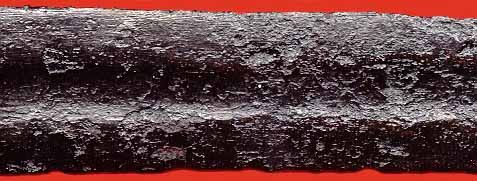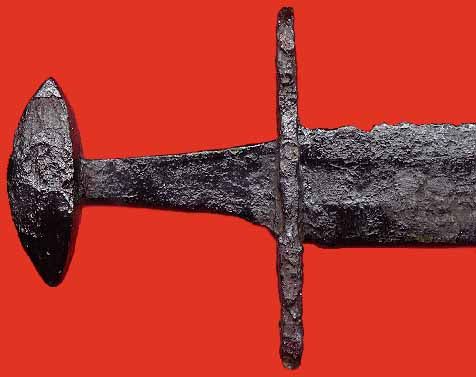Late Viking Age / Medieval Oakeshott Type X Sword
Jul 12, 2013 9:40:26 GMT
Post by Jack Loomes on Jul 12, 2013 9:40:26 GMT




Find place: Unknown
Collection: Private
Length Overall: 95.0 cm. Blade: 82.1 cm.
Date: 950 to 1100 AD
Condition: Excavated with moderate to severe pitting, minimally bent, opaque painted surface.
Exhibiton: Higgins Armory Museum, Worcester, MA (current)
This mildly tapering, broadly fullered blade is characteristic of those seen in the later half of the Viking Age, and on the basis of this blade shape, in accordance with Oakeshott's classification, this sword is classified as Type X. Although largely lost and obscured by corrosion and the painted finish, a strong suggestion of a tall lettered iron-inlaid inscription remains on both sides of the third of the blade nearest the hilt. The very end of the tip of the blade is missing (about 1 to 2 cm.).
Oakeshott favors a central or eastern European origin for the brazil-nut pommel form (Sword in the Age of Chivalry, 1964, p. 82) and extensively covers its variations (p. 80 to 94). In his description of type X, Petersen illustrates (Norske Vikingesverd, 1919, p. 166 - 167, fig 129) a pommel, otherwise of "tea-cosy" form, with a convex underside (facing the hand) associated with a crossguard longer than that usually associated with Viking swords. Compared with the straight flat surface usually against the small finger and ulnar aspect of the hand in sword pommels and upper guards typical of the Viking Age (i.e. M.1, X.4 herein), the brazil-nut pommel, with its convex surface, allows a greater range of wrist motion without sacrificing comfort to the hand (Sword in the Age of Chivalry, 1964, p. 87).
While commonplace later, long guards did exist in the later Viking Age and were termed gaddhjalt or "spike-hilt" in the sagas (Falk, 1937, p. 380, Oakeshott, 1964, p. 113 and Oakeshott, 1991, p.27). Oakeshott illustrates a brazil-nut pommel similar in profile to the present example as X.13 (Oakeshott, 1991, p. 32) which has an INGELRII iron-inlaid inscription and another INGELRII inlaid blade with a pommel transitional between the tea-cosy and fully-developed brazil-nut as X.9 (p. 27); the latter remaining in extraordinarily fine condition and presently in Glasgow (see also Scott, 1980, p. 11.)
Both sides of this sword exhibit moderate to severe pitting. The manner in which the pommel is mounted upon the tang is inapparent in the present state of conservation. The width of the pommel is 9.2 cm. The surface of the pommel facing the tang is convex, both across the depth and length of this face. Similarly, the two "faces" of the pommel are convex and of equal size with the pommel being thinner than it is long. The lower guard (crossguard), when viewed on end, is essentially a heavily corroded iron bar with squared ends having a maximum depth (centrally, from the plane of the photograph) of about 1.8 cm. which is reduced to about 1 cm. toward either tip. While the degree of corrosion at the tips of the crossguard is sufficient to mask whether the quillons had once been longer, the remaining symmetry suggests that the present crossguard length is likely close to the original proportions.
This close-up above is of the opposite surface from that pictured with the hilt and is an area in the proximal third of the blade showing irregularities in the pattern of corrosion suggesting an iron-inlaid inscription in large letters such as are associated with INGELRII and ULFBERHT inscribed swords. The close-up below is of the opposite side (the same side as the hilt close-up) and is from the mid-portion of this blade and shows a broad, shallow central fuller occupying about one-third of overall blade length. The surface contour irregularities suggesting an iron-inlay are absent here and toward the tip of the blade.
Extract from Records of the Medieval Sword by Ewart Oakeshott regarding Type X: www.sword-site.com/thread/118/oakeshott-type-records-medieval-sword
To see the Petersen Typology click here: sword-site.com/thread/845/petersens-classification-typology-viking-swords
Source: www.vikingsword.com/vmuseum/vmx17.html

.png?width=1920&height=1080&fit=bounds)